Unit 1
Basic Circuit Concept
Resistor

Control the flow of current
V=IR
P=I2R

Behaviour of Resistance-

t=0- t=0 t=0+ t=∞
R R R R


Inductor
- Active - FET, diode
- Passive - R, L, C
Storage of energy
Based on electromagnetic induction
Faraday’s Law
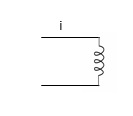
Φ∝ i
Φ = L.i







Relaxed inductor I0 = 0


Current Carrying Inductor:

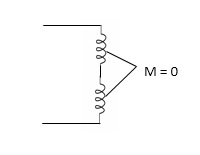
L = L1+L2



Capacitor:
Charge storing device (voltage)
Q ∝ V
Q = C V





Relaxed capacitor 
charged capacitor
Electrostatic Energy

Inductor do not respond any change as far as current is concerned.
Capacitor does not respond any change as far as voltage is concerned.
Definition of Open circuit and short circuit

R=∞
V=0 or V≠ 0
I=0
Short Circuit:
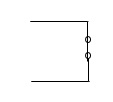
V = 0
R = 0
I may or may not be zero
1) Active and Passive Elements:
The elements which deliver power or energy are called as Active elements. For example: Transistor, Voltage and Current source.
The elements which absorb power are called as passive elements. For example: Resistor, Inductor and capacitor.
2) Unilateral and Bilateral Elements:
The unilateral elements allow the flow if current in only one direction. Ex. Diode.
The bilateral element allows the flow of current in both the directions. Ex. Resistor, inductor and capacitor.
3) Linear and Non-Linear:
The elements which obey ohms law or have linear relationships are known as Linear elements. Ex. Resistor, inductor and capacitor.
The elements which do not obey ohms law are known as Non-Linear elements.
- Voltage Source: A voltage source always have a resistance in series.

Ideal source
R = 0
Practical = 2 - 5Ω
I = 0

2. Current Source: Always have R parallel with the source.





Ideal and Practical Sources (Independent Sources only)
Ideal and practical Voltage and Current source:
A voltage source is a device which provides a constant voltage to load at any instance of time and is independent of the current drawn from it. This type of source is known as an ideal voltage source. Practically, the ideal voltage source cannot be made. It has zero internal resistance. It is denoted by this symbol.

Fig: Voltage source symbol
Ideal Voltage Source

Fig: Ideal Voltage Source
The graph represents the change in voltage of the voltage source with respect to time. It is constant at any instance of time.
Voltage sources that have some amount of internal resistance are known as a practical voltage source. Due to this internal resistance, voltage drop takes place. If the internal resistance is high, less voltage will be provided to load and if the internal resistance is less, the voltage source will be closer to an ideal voltage source. A practical voltage source is thus denoted by a resistance in series which represents the internal resistance of source.
Practical Voltage source

Fig: Practical Voltage source
The graph represents the voltage of the voltage source with respect to time. It is not constant but it keeps on decreasing as the time passes.
Current source
A current source is a device which provides the constant current to load at any time and is independent of the voltage supplied to the circuit. This type of current is known as an ideal current source; practically ideal current source is also not available. It has infinite resistance. It is denoted by this symbol.
Ideal Current source

Fig: Ideal Current source
The graph represents the change in current of the current source with respect to time. It is constant at any instance of time.
Why ideal Current source has infinite resistance?
A current source is used to power a load, so that load will turn on. We try to supply 100% of the power to load. For that, we connect some resistance to transfer 100% of power to load because the current always takes the path of least resistance. So, in order for current to go to the path of least resistance, we must connect resistance higher than load. This is why we have the ideal current source to have infinite internal resistance. This infinite resistance will not affect voltage sources in the circuit.
Practical Current source
Practically current sources do not have infinite resistance across there but they have a finite internal resistance. So, the current delivered by the practical current source is not constant and it is also dependent somewhat on the voltage across it.
A practical current source is represented as an ideal current source connected with resistance in parallel.

Fig; Practical Current source
The graph represents the current of the current source with respect to time. It is not constant but it also keeps on decreasing as the time passes.
Statement: the algebraic summation of all Voltage in any closed circuit or mesh of loop zero.
Ie ∑ Voltage in closed loop = 0 the summation of the Voltage rise (voltage sources) is equal to summation of the voltage drops around a closed loop in 0 circuit for explanation from here
Determination of sigh and direction of currents (Don’t write in exams just for understanding)

Current entering a resistor is +ve and leaving should be –ve
Now



Potential Rise Potential Drop

We are reading from +V to –V we are reading from –V to +V
 potential drops
potential drops  potential rise
potential rise
 -V
-V  +V
+V
Given Circuit

First identify no of loops and assign direction of current flowing in loop
Note: no of loops in circuit = No, of unknown currents = no, of equations in the circuit

Note: keep loop direction and current direction same i.e either clockwise or anticlockwise for all loops I1 I2
Now according to direction of direction assign signs (+ve to –ve) to the resistors

Note: voltage sources (V) polarities does not change is constant.
Note: for common resistor between 2 loops appearing in the circuit like R3 give signs according to separate loops as shown

When considering only loop no 1 (+ R3 - )
- B

Now consider diagram A and write equations
Two loops  two unknown currents
two unknown currents  two equation
two equation
Apply KVL for loop ① [B. Diagram]
(+ to drop-) = - sign and (- to rise +) = + sign
 for drop = -sign
for drop = -sign
 for rise = + sign
for rise = + sign
-
-( ) R2 is considered because in R3,2 currents are flowing
) R2 is considered because in R3,2 currents are flowing  and
and  and we have taken (
and we have taken ( ) because we are considering loop no 1 and current flowing is
) because we are considering loop no 1 and current flowing is  in loop no 1
in loop no 1
 )
)
Similarly, for loop no. 2 currents flowing is  resistor R3 it should be
resistor R3 it should be  )R3
)R3

Consider loop no. 1 apply KVL
- …….①
…….①
-
Consider loop no. 2 apply KVL
- …….②
…….②
-
After solving equation ① and ② we will get branch current  and
and 
Star-Delta



Delta-Star



RA=
RB=
RC=
Q1) For the circuits given below write the voltage equations:

Solution: Let current i1be in loop 1 current and i2 for loop 2



Q2) For the circuits given below write the voltage equations

Solution:
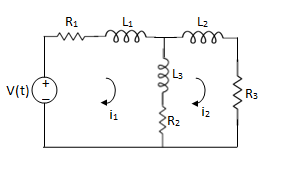
For loop 1

For loop 2

Q3) Using nodal analysis find voltage across 5resistor.

Solution:
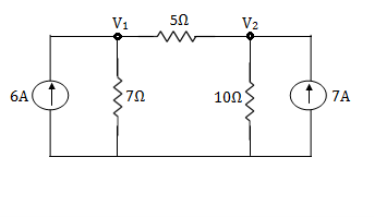
For V1


 1
1
For V2


 2
2
Solving 1 and 2:


For 5 voltage = 
= -50.9 + 57.27
= 6.37V
Q4)Find 

Sol:


Q5) Find 

Sol: 

Q6) . Find the current through  resistance.
resistance.

Solution:

 1= 0
1= 0

 2=
2=
 1 +
1 +  2
2 
Special Case:
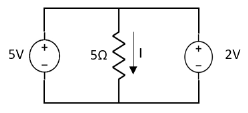
Since two voltage sources with different magnitude in parallel which cannot be connected as in single branch two different current is not possible (if 5V than I = zero).
Q7)



 1 =
1 = 
 2 =
2 = 
=
 1 +
1 +  2
2
= 
Q8) Use nodal analysis to find current in the circuit?
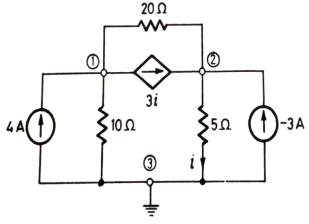
Sol:  +
+  +3i=4
+3i=4
 +
+  -3i= -3
-3i= -3
But i= 
Substituting and solving above equation we get
V2 = 10V
i=  = 2A
= 2A
Q9) Find equivalent resistance R?

Sol: Equivalent resistance across ab =  = 4Ω
= 4Ω
Equivalent resistance across cd =  =1 Ω
=1 Ω
Req = Rab||Rcd +3 =  + 3 = 19/5 Ω
+ 3 = 19/5 Ω